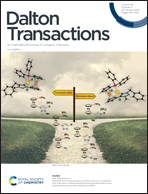DO2A-based ligands for gallium-68 chelation: synthesis, radiochemistry and ex vivo cardiac uptake†
Abstract
Radiolabelled lipophilic cations could potentially be used to non-invasively image mitochondrial dysfunction in cardiovascular disease, building on their current role as perfusion imaging agents. We have synthesised and radiolabelled two series of DO2A-based radiotracers, with bistriarylphosphonium- and bisaryl-functionalisation respectively, with gallium-68 to form lipophilic cations. Both sets of tracers radiolabel with over 90% RCP, although the tracers form kinetic/thermodynamic pairs of species upon gallium chelation that can be visualised and separated by radioHPLC. Log D7.4 values above −0.3 are observed for the most lipophilic examples of each series of radiotracers. Both tracers show significant preferential uptake in healthy cardiac tissue over cardiac tissue depolarised by CCCP.

- This article is part of the themed collection: Celebrating our 2020 Prize and Award winners


 Please wait while we load your content...
Please wait while we load your content...